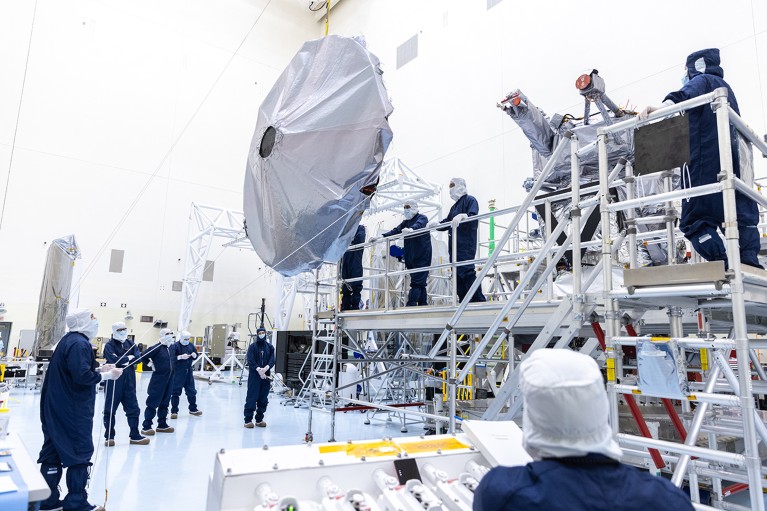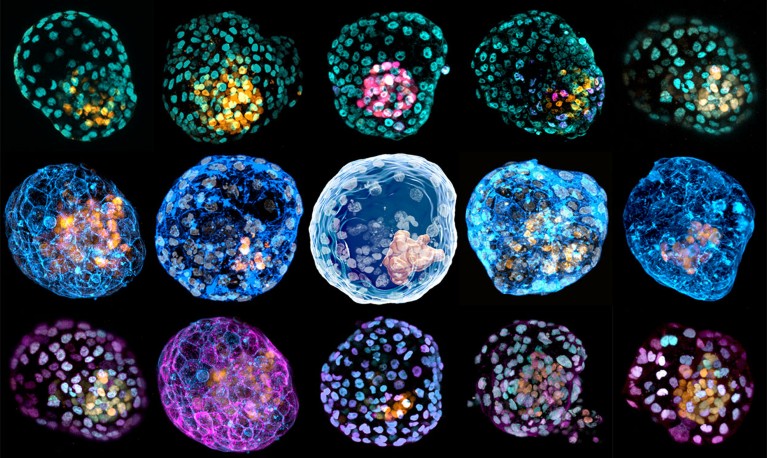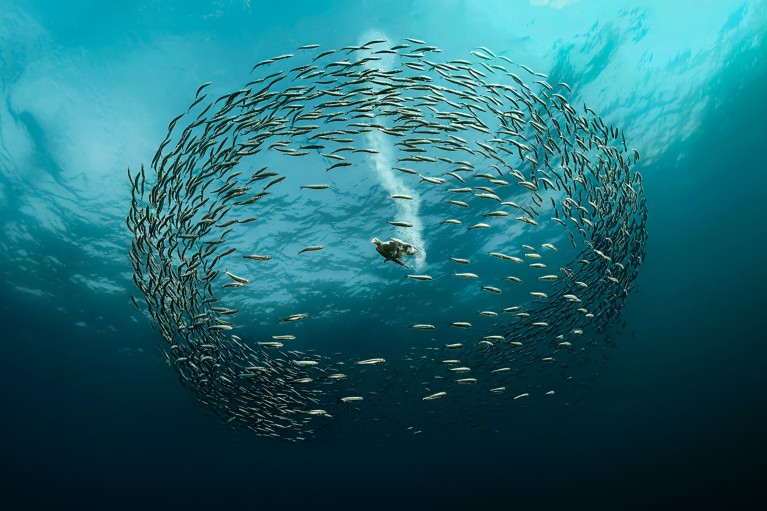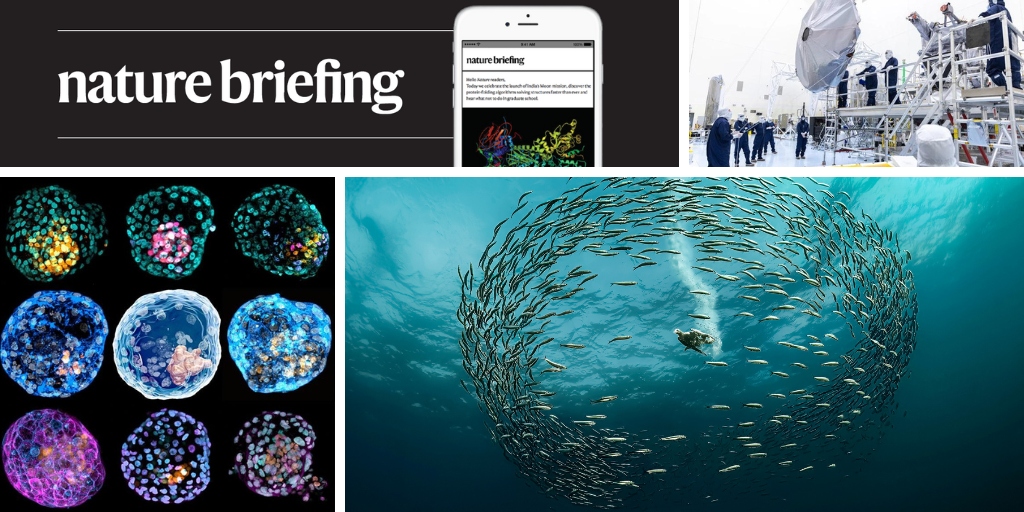Hello Nature readers, would you like to get this Briefing in your inbox free every day? Sign up here.

Technicians prepare to install Europa Clipper’s 3-metre-wide antenna on the spacecraft on 17 June at the Kennedy Space Center in Cape Canaveral, Florida.Credit: NASA/Kim Shiflett
NASA has confirmed that its Europa Clipper mission will launch as planned. The news comes after possibly faulty transistors installed on the US$5-billion spacecraft risked causing a significant delay. Now past the final review stage, the mission’s launch window opens on 10 October. If the launch is successful, the orbiter will arrive at Jupiter’s moon in 2030 to investigate its icy crust and the ocean — perhaps harbouring life — that scientists suspect lies beneath it.
The lateral fabella, a bone in the knee the size of a sesame seed, might have helped humans to start walking upright. Researchers suggest that the bone, which is found in only 39% of people and linked to osteoarthritis, evolved differently in early humans compared with other primates. The distinct pathway could point to an evolutionary change that helped humans’ ancestors take their first steps on two legs. “People 1726138341 are better nourished, and therefore are taller and weigh more, providing the mechanical stimulus for the bone to form,” says mechanical engineer and co-author Michael Berthaume — which might explain why the bone has become more common in humans over the last 100 years.
Reference: Proceedings of the Royal Society B paper
The coastal city of Linhares in Brazil has legally recognized its iconic waves as living beings with intrinsic rights. Waves near the mouth of the Doce River have a characteristic tubular break beloved of surfers. They were disrupted in 2015 when an upstream dam collapsed, releasing waste material from an iron ore mine and killing 19 people. Linhares’s new law also protects bodies of water connected to the waves. “When you recognize a little bit of space of the ocean, like these waves, you are reaching the whole ocean,” says environmental lawyer Vanessa Hasson.
A billionaire who funded much of his own mission could soon become the first non-professional astronaut to step into space. Entrepreneur Jared Isaacman and another civilian astronaut, engineer Sarah Gillis, will attempt the spacewalk on Thursday during SpaceX’s Polaris Dawn mission — despite the Dragon capsule’s lack of an airlock (the whole thing will be depressurized before they head out). Yesterday, the mission reached an orbit of 1,400 kilometres from Earth — the farthest people have been since the end of NASA’s Apollo Moon programme.
Features & opinion

Models of human embryos at the blastocyst stage, which are called blastoids.Credit: Monash Univ.
Labs across the world are racing to grow the best likeness of a human embryo. Studying stem-cell derived embryo models could demystify the first weeks after conception, helping to address infertility, prevent diseases that emerge early in development and test the safety of drugs for embryos. The field is booming, but as the models become increasingly complex, they are starting to raise ethical questions that are leaving experts scrambling to keep up. The key challenge for researchers who are developing guidelines is determining “when an embryo model would be considered equivalent to an embryo”, says Amander Clark, a developmental and stem-cell biologist.
“The Arctic is likely to become a hotbed for zoonotic diseases that spill over into humans from other animals,” argues Arctic ecoscientist Christian Sonne. The natural balance is being upset by pollutants, invasive pathogens and melting ice, and ancient microorganisms are also being released as the landscape thaws. He calls for a ‘One Health’ approach that integrates an understanding of the effects on wildlife, humans and ecosystems. For example, food-safety efforts and better disease surveillance could help reduce the risk of spillover events in places where meat is processed by subsistence-hunting communities.
In July, the European Medicines Agency (EMA) rejected the clinical use of lecanemab for Alzheimer’s disease. Henrik Zetterberg, a clinical neurochemist who has spent 20 years researching the disease, thinks the EMA made a mistake — partly because it declines advice from scientists who work with industry. “On the surface, this precaution might seem sensible and straightforward, to prevent biased decision-making,” writes Zetterberg. “But researchers with links to the pharmaceutical industry are often best placed to assess new medicines — and many universities see forging links with industry as a key part of a scientist’s job.”
Image of the week

Credit: Wayne Lai/Big Picture Competition
Underwater photographer Wayne Lai used a strobe light to illuminate the murky waters off the coast of South Africa, and so captured the moment a Cape gannet (Morus capensis) dived straight into a circular shoal of sardines. The fish had been driven to the surface by dolphins circling underneath, providing a perfect snacking opportunity for the seabird. The shot won the People’s Choice Award in the 2024 Big Picture: Natural World Photography competition.
See more of the month’s sharpest science shots, selected by Nature’s photo team. (Wayne Lai/Big Picture Competition)
Today I’m enjoying watching 1.8 billion years of tectonic plate movements in just over a minute. Researchers mapped the “continental dance” of land during the last 40% of Earth’s history, including a look back at the supercontinents Pangaea and Gondwana, their predecessor Rodinia and an even older supercontinent called Nuna.
Help this newsletter break apart and reform into a better version of itself by sending us your feedback. Your e-mails are always welcome at [email protected].
Thanks for reading,
Flora Graham, senior editor, Nature Briefing
With contributions by Jacob Smith
Want more? Sign up to our other free Nature Briefing newsletters:
• Nature Briefing: Microbiology — the most abundant living entities on our planet — microorganisms — and the role they play in health, the environment and food systems.
• Nature Briefing: Anthropocene — climate change, biodiversity, sustainability and geoengineering
• Nature Briefing: AI & Robotics — 100% written by humans, of course
• Nature Briefing: Cancer — a weekly newsletter written with cancer researchers in mind
• Nature Briefing: Translational Research — covers biotechnology, drug discovery and pharma


